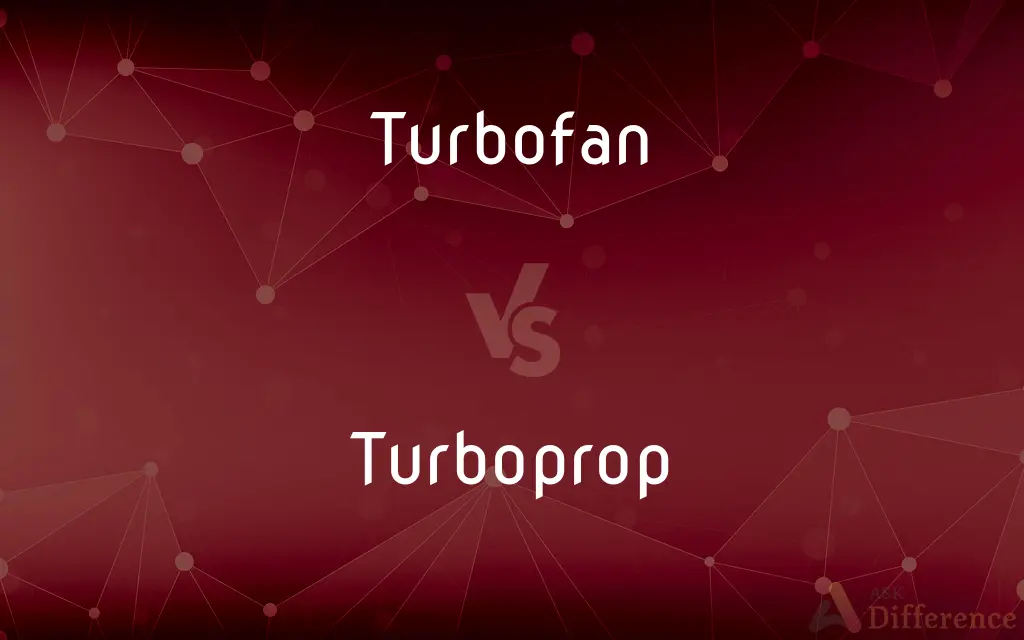Turbofan vs. Turboprop — What's the Difference?
Edited by Tayyaba Rehman — By Fiza Rafique — Updated on September 28, 2023
A turbofan is a jet engine that uses a large fan to generate thrust efficiently, commonly used in commercial airliners. A turboprop is an aircraft propulsion system that uses a gas turbine to turn a propeller.

Difference Between Turbofan and Turboprop
Table of Contents
ADVERTISEMENT
Key Differences
A turbofan is a type of aircraft jet engine known for its efficiency and use in commercial aviation. It operates on the principle of sucking in air, compressing it, mixing it with fuel, and igniting it to produce thrust. Turbofans are characterized by a large fan at the front, which accelerates a significant amount of air around the engine core. This design generates a substantial portion of the engine's thrust, making it fuel-efficient for long-haul flights. Turbofans are commonly found on commercial airliners like Boeing 737 or Airbus A320.
Turboprop, on the other hand, is a different aircraft propulsion system. It also uses a gas turbine engine, but instead of jet thrust, it drives a propeller. Turboprops are known for their reliability, versatility, and suitability for shorter routes. They are often used in regional and commuter aircraft like the ATR 72 or Dash 8. Turboprops are efficient at lower speeds and altitudes, making them suitable for shorter runways and routes with frequent takeoffs and landings.
In summary, while both turbofans and turboprops are aircraft engines, turbofans are known for their use in large, long-haul commercial aircraft, emphasizing efficiency, whereas turboprops are commonly found in smaller aircraft, prioritizing reliability and suitability for shorter routes.
Comparison Chart
Propulsion
Uses a large fan for jet thrust
Drives a propeller for thrust
Common Usage
Commercial airliners
Regional and commuter aircraft
ADVERTISEMENT
Efficiency
Efficient for long-haul flights
Efficient at lower speeds and altitudes
Speed and Range
Higher speeds and longer ranges
Lower speeds and shorter ranges
Typical Aircraft
Boeing 737, Airbus A320
ATR 72, Dash 8
Takeoff/Landing
Suitable for larger airports
Suitable for shorter runways
Compare with Definitions
Turbofan
Turbofan engines provide high-speed propulsion for fast, long-haul travel.
The turbofan-powered aircraft reached its destination swiftly.
Turboprop
Turboprop aircraft can take off and land on shorter runways.
The turboprop's versatility includes short runway use.
Turbofan
Turbofans compress and accelerate air to produce thrust for propulsion.
The turbofan's compression system enhances efficiency.
Turboprop
Turboprops are chosen for their reliability in various aviation applications.
The turboprop engine is renowned for its dependability.
Turbofan
Turbofans are commonly used in commercial airliners for their fuel efficiency.
The Boeing 787 relies on turbofan engines.
Turboprop
Turboprop engines use a gas turbine to drive a propeller for thrust.
Turboprops are known for their propeller-driven engines.
Turbofan
In modern jetliners, turbofans are the primary source of thrust.
The turbofan's power ensures a smooth and efficient flight.
Turboprop
Turboprops are commonly found in regional and commuter aircraft.
The turboprop aircraft serves short-haul routes.
Turbofan
A turbofan is an aircraft engine with a large fan that generates thrust efficiently.
The turbofan engines powered the long-haul flight.
Turboprop
Turboprops operate efficiently at lower speeds and altitudes.
Turboprops excel in slower, scenic flights.
Turbofan
The turbofan or fanjet is a type of airbreathing jet engine that is widely used in aircraft propulsion. The word "turbofan" is a portmanteau of "turbine" and "fan": the turbo portion refers to a gas turbine engine which achieves mechanical energy from combustion, and the fan, a ducted fan that uses the mechanical energy from the gas turbine to accelerate air rearwards.
Turboprop
A turboprop engine is a turbine engine that drives an aircraft propeller.A turboprop consists of an intake, reduction gearbox, compressor, combustor, turbine, and a propelling nozzle. Air is drawn into the intake and compressed by the compressor.
Turbofan
A turbojet engine in which a fan supplements the total thrust by forcing air directly into the hot turbine exhaust.
Turboprop
A turbojet engine used to drive an external propeller.
Turbofan
An aircraft in which a turbofan is used. In both senses also called fanjet.
Turboprop
An aircraft in which a turboprop is used. Also called propjet.
Turbofan
(aviation) A turbojet engine having a (typically ducted) fan that forces air directly into the hot exhaust and obtains a portion of the thrust from the turbojet and a portion from the turbojet section.
Turboprop
(aeronautics) A type of gas turbine aircraft engine that drives and obtains essentially all thrust from an external (typically unducted) propeller.
Turbofan
Jet engine in which a turbine drives air to the burner
Turboprop
(aviation) An aircraft that uses a turboprop engine.
Turboprop
Airplane powered by a turbojet engine
Turboprop
An airplane with an external propeller that is driven by a turbojet engine
Common Curiosities
Can turbofan-powered aircraft operate from smaller airports?
Turbofan-powered aircraft are typically designed for larger airports with longer runways.
Where are turbofan engines commonly used?
Turbofan engines are commonly used in commercial airliners for long-haul flights.
What is the typical speed and range of aircraft with turboprop engines?
Aircraft with turboprop engines operate at lower speeds and shorter ranges, making them ideal for short-haul travel.
What distinguishes turbofans from other engines?
Turbofans are known for their efficiency and the use of a large fan to produce a significant portion of thrust.
Where are turboprop engines commonly used?
Turboprop engines are commonly found in regional and commuter aircraft for shorter routes.
What is the typical speed and range of aircraft with turbofan engines?
Aircraft with turbofan engines are known for higher speeds and longer ranges, making them suitable for long-haul travel.
What is a turbofan engine?
A turbofan engine is an aircraft propulsion system that uses a large fan to generate jet thrust efficiently.
What distinguishes turboprops from other engines?
Turboprops are known for their reliability and suitability for shorter flights.
What is a turboprop engine?
A turboprop engine is an aircraft propulsion system that uses a gas turbine to drive a propeller for thrust.
Can turboprop-powered aircraft operate from smaller runways?
Yes, turboprop-powered aircraft are designed to take off and land on shorter runways, providing flexibility in airport selection.
Share Your Discovery

Previous Comparison
Confiscation vs. Expropriation
Next Comparison
Capability vs. FunctionAuthor Spotlight
Written by
Fiza RafiqueFiza Rafique is a skilled content writer at AskDifference.com, where she meticulously refines and enhances written pieces. Drawing from her vast editorial expertise, Fiza ensures clarity, accuracy, and precision in every article. Passionate about language, she continually seeks to elevate the quality of content for readers worldwide.
Edited by
Tayyaba RehmanTayyaba Rehman is a distinguished writer, currently serving as a primary contributor to askdifference.com. As a researcher in semantics and etymology, Tayyaba's passion for the complexity of languages and their distinctions has found a perfect home on the platform. Tayyaba delves into the intricacies of language, distinguishing between commonly confused words and phrases, thereby providing clarity for readers worldwide.













































